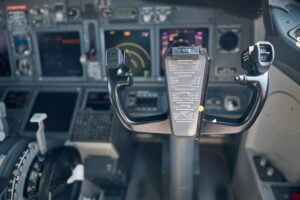The aviation industry heavily relies on complex avionics systems to ensure safe and efficient flight operations. At the heart of these systems are Aircraft Interface Devices (AIDs), which serve as the interface between various avionics components and the aircraft’s crew. One of the key standards governing the design and implementation of these interface devices is ARINC 601.
ARINC 601 is a standard established by Aeronautical Radio, Incorporated (ARINC) to define the specifications for aircraft interface devices, particularly those related to cockpit displays.
Originally introduced in the late 1980s, ARINC 601 has become a cornerstone in the aviation industry, providing guidelines for manufacturers and operators to ensure interoperability and compatibility among avionics systems.
This standard outlines essential parameters such as display characteristics, data formatting, electrical interfaces, and mechanical requirements, all of which are crucial for the seamless integration and operation of avionics equipment on aircraft.
By adhering to ARINC 601 specifications, manufacturers can develop products that meet the stringent safety and reliability standards required for aviation applications.
In this comprehensive guide, we will delve into the intricacies of ARINC 601, exploring its history, components, applications, advantages, and challenges. Through this exploration, we aim to provide a deeper understanding of how ARINC 601 contributes to the evolution of avionics systems and the broader aviation industry as a whole.

Understanding ARINC Standards
A. Introduction to ARINC Standards:
Aeronautical Radio, Incorporated (ARINC) is a leading provider of technical standards and solutions for the aviation industry. ARINC standards encompass various topics, from communication protocols to avionics systems and beyond. These standards play a vital role in ensuring interoperability, safety, and efficiency across various aviation applications.
B. ARINC 601: Scope and Objectives:
ARINC 601 is among the many standards developed by ARINC, specifically focusing on aircraft interface devices, particularly those related to cockpit displays. The primary objective of ARINC 601 is to establish a common set of specifications and guidelines for manufacturers to follow when designing and implementing avionics systems, ensuring consistency and compatibility across different aircraft platforms.
ARINC 601 covers key aspects such as display characteristics, data formatting, electrical interfaces, and mechanical requirements. By providing clear guidelines in these areas, the standard facilitates the development of avionics equipment that meets the stringent requirements of the aviation industry, including reliability, safety, and performance.
Components and Specifications of ARINC 601
ARINC 601 delineates a comprehensive set of specifications governing the design and operation of aircraft interface devices, particularly focusing on cockpit displays. Understanding the components and specifications outlined in this standard is crucial for manufacturers, engineers, and operators in the aviation industry. Let’s delve into the key elements:
A. Display Characteristics:
- Resolution: ARINC 601 defines the resolution requirements for cockpit displays, specifying the number of pixels horizontally and vertically to ensure clarity and readability of information.
- Color Depth: The standard outlines the acceptable color depth for displays, which determines the range of colors that can be accurately represented.
- Brightness and Contrast: ARINC 601 specifies criteria for brightness and contrast levels to ensure optimal visibility under varying lighting conditions within the cockpit.
B. Data Formatting:
- Data Formats: ARINC 601 standardizes the formats for various types of data that are displayed on cockpit screens, including flight data, navigation information, weather data, and system status indicators.
- Communication Protocols: The standard may also cover communication protocols used to transmit data between avionics systems and cockpit displays, ensuring compatibility and interoperability.
C. Electrical Interface:
- Voltage and Current Requirements: ARINC 601 defines the electrical characteristics of the interface between cockpit displays and avionics systems, including voltage levels, current ratings, and power consumption limits.
- Signal Integrity: Specifications related to signal integrity are crucial to maintain reliable communication between devices and prevent data corruption or loss.
D. Mechanical Requirements:
- Form Factor: ARINC 601 may specify the physical dimensions and form factor of cockpit displays to ensure compatibility with mounting systems and available space within the aircraft cockpit.
- Durability and Environmental Resistance: The standard may include requirements for ruggedness, shock resistance, and environmental sealing to withstand the demanding operating conditions experienced in aviation environments.
Applications and Uses of ARINC 601
- ARINC 601, as a standard governing the design of aircraft interface devices, finds widespread applications across various aspects of aviation.
- Its specifications cater to the needs of cockpit displays, flight management systems, in-flight entertainment systems, and maintenance and diagnostics equipment.
- Understanding the diverse applications and uses of ARINC 601 sheds light on its significance in modern aviation.
Cockpit Displays:
- ARINC 601 plays a pivotal role in shaping the functionality and performance of cockpit displays, which are critical for providing flight crews with essential information for navigation, monitoring, and control during flight operations.
- Whether it’s primary flight displays, multifunction displays, or electronic flight bags, adherence to ARINC 601 ensures consistency in display characteristics, data formatting, and interface compatibility.
- This uniformity enhances situational awareness, improves decision-making, and contributes to flight safety.
Flight Management Systems (FMS):
- Flight management systems rely on accurate and standardized data exchange to perform functions such as flight planning, navigation, and autopilot control.
- ARINC 601 specifications facilitate seamless communication between FMS components and cockpit displays, ensuring the proper presentation of flight plans, waypoints, weather data, and other crucial information to the flight crew.
- By adhering to ARINC 601, manufacturers can develop FMS solutions that integrate seamlessly with other avionics systems, enhancing overall flight efficiency and operational capability.
In-Flight Entertainment Systems (IFE):
- In-flight entertainment systems have become integral to the passenger experience, providing entertainment, information, and connectivity during flights.
- ARINC 601 standards extend to the design and implementation of display interfaces and control mechanisms for IFE systems, ensuring compatibility with aircraft avionics and safety requirements.
- By following ARINC 601 guidelines, manufacturers can develop IFE solutions that offer a seamless and intuitive user experience while maintaining compliance with aviation regulations.
Maintenance and Diagnostics:
- Effective maintenance and diagnostics are essential for ensuring the continued airworthiness and reliability of aircraft systems.
- ARINC 601 specifications facilitate the integration of diagnostic tools and equipment with aircraft avionics, allowing maintenance personnel to monitor system health, perform troubleshooting, and conduct software updates as needed.
- By adhering to ARINC 601 standards, operators can streamline maintenance procedures, reduce downtime, and minimize the risk of in-flight system failures.
Conclusion
ARINC 601 stands as a crucial standard in aviation, ensuring compatibility and interoperability among aircraft interface devices. Its specifications have shaped cockpit displays, flight management systems, in-flight entertainment, and maintenance tools, contributing to safety and efficiency in aviation operations. By adhering to ARINC 601, manufacturers develop reliable products meeting industry standards, while operators benefit from enhanced functionality and seamless integration. ARINC 601 remains essential as aviation technology advances, fostering innovation while maintaining safety and reliability standards. In essence, ARINC 601 embodies the industry’s commitment to excellence in avionics technology.






